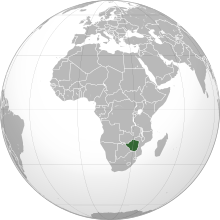
Bulawayo is the second largest city in Zimbabwe, and the largest city in the country's Matabeleland region. The city's population is disputed; the 2022 census listed it at 665,940, while the Bulawayo City Council claimed it to be about 1.2 million. Bulawayo covers an area of about 546 square kilometres in the western part of the country, along the Matsheumhlope River. Along with the capital Harare, Bulawayo is one of two cities in Zimbabwe that is also a province.
Ndabaningi Sithole founded the Zimbabwe African National Union (ZANU), a militant organisation that opposed the government of Rhodesia, in July 1963. Sithole was a progeny of a Ndau father and a Ndebele mother. He also worked as a United Church of Christ in Zimbabwe (UCCZ) minister. He spent 10 years in prison after the government banned ZANU. A rift along tribal lines split ZANU in 1975, and he lost the 1980 elections to Robert Mugabe.
Jonathan Nathaniel Mlevu Moyo is a Zimbabwean politician who served in the government of Zimbabwe as Minister of Higher Education from 2015 to 2017. He was previously Minister of Information and Publicity from 2000 to 2005 and again from 2013 to 2015. He was elected to the House of Assembly of Zimbabwe as an independent candidate in 2005 and 2008. He is considered the core architect of the AIPPA and POSA restrictive legislation.

Parliamentary elections were held in Zimbabwe on 31 March 2005 to elect members to the Zimbabwe House of Assembly. All of the 120 elected seats in the 150-seat House of Assembly were up for election.

Mabvuku is a suburb east of Harare, the capital city of Zimbabwe.

Chitungwiza is an urban centre and town of Harare Province in Zimbabwe.
Operation Murambatsvina, also officially known as Operation Restore Order, was a large-scale Zimbabwean government campaign to forcibly clear slum areas across the country. The campaign started in 2005 and according to United Nations estimates has affected at least 700,000 people directly through loss of their homes or livelihood and thus could have indirectly affected around 2.4 million people. Robert Mugabe and other government officials characterised the operation as a crackdown against illegal housing and commercial activities, and as an effort to reduce the risk of the spread of infectious disease in these areas.

Killarney is a suburb of Bulawayo, Zimbabwe. It is named after the town of Killarney in Co. Kerry in southwest Ireland. It includes a squatted informal settlement also called Killarney.

Beitbridge is a border town in the province of Matabeleland South, Zimbabwe. The name also refers to the border post and bridge spanning the Limpopo River, which forms the political border between South Africa and Zimbabwe. The border on the South African side of the river is also named Beitbridge.
The following lists events that happened during 2005 in the Republic of Zimbabwe.
The following lists events that happened during 2000 in Zimbabwe.

Emmerson Dambudzo Mnangagwa is a Zimbabwean revolutionary and politician who has served as President of Zimbabwe since 24 November 2017. A member of ZANU–PF and a longtime ally of former President Robert Mugabe, he held a series of cabinet portfolios and was Mugabe's Vice President until November 2017, when he was dismissed before coming to power in a coup d'état. He secured his first full term as president in the disputed 2018 general election.
Enos Mzombi Nkala was one of the founders of the Zimbabwe African National Union.
Articles related to Zimbabwe include:

Mbare is a suburb in the south of Harare, Zimbabwe. Founded in 1907 as a township, it includes an informal settlement. Mbare Musika is the largest farm produce market in Zimbabwe.
Zimbabwe began experiencing a period of considerable political and economic upheaval in 1999. Opposition to President Mugabe and the ZANU-PF government grew considerably after the mid-1990s in part due to worsening economic and human rights conditions. The Movement for Democratic Change (MDC) was established in September 1999 as an opposition party founded by trade unionist Morgan Tsvangirai.
Joseph Chinotimba is a Zimbabwean political figure. He rose to prominence during the invasions of white-owned commercial farms that started after the 2000 referendum in Zimbabwe. He is widely regarded as a militant ZANU-PF cadre with unquestionable allegiance to the old guard of the ruling party. He is the National Vice-Chairman of the Zimbabwe National Liberation War Veterans Association.

Harare Metropolitan Province is a province in northeastern Zimbabwe. It comprises Harare, the country's capital and most populous city, and two other municipalities. Originally part of Mashonaland Province, in 1983 the province was divided into three large provinces, Mashonaland Central, Mashonaland East, and Mashonaland West, while the city of Harare became its own metropolitan province, along with two nearby cities. Harare Province is divided into four districts. Oliver Chidawu is the current Minister of State for Provincial Affairs, Harare Metropolitan Province, since March 2019. provincial governor.
Blue Roof is the common name given to a mansion and former presidential palace in the suburb of Borrowdale in Harare, Zimbabwe. It was built in 2006 by the ZANU-PF political party as a family home for the then President of Zimbabwe Robert Mugabe. Following his death, ownership was transferred to the Mugabe family.











